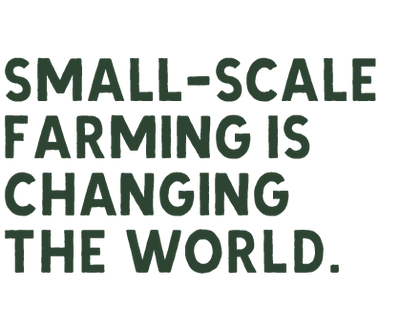Text by Av Singh
Illustration by Simon Bossé
"Falling back on the old adage ‘you are what you eat,’ it becomes imperative that we grow our food and medicine in less chronically stressed environments so they can possess the desired nutrients to address the chronic stresses that we face as humans.”
Bare soil and frequent tillage are the leading causes of oxidative stress in our crops. What is oxidative stress? Similar to what happens in humans, plant cells produce oxygen-rich protective compounds (free radicals) to help maintain cellular homeostasis (balance). However, in high stress situations, they cannot produce enough antioxidants to keep these compounds in check. The resulting imbalance causes an inflammatory response. In humans, factors like a sedentary lifestyle, a highly processed diet, consumption of non-grass-fed red meat, excessive alcohol consumption, smoking, and stress can lead to chronic inflammation (similar to that in plants). These are now being linked to several diseases like diabetes, cardiovascular illnesses, and cancer.
One of the best ways of addressing chronic inflammation in the human body is to consume colorful vegetables and leafy greens that are chock-full of antioxidants like flavonoids (e.g., anthocyanins, resveratrol, curcumin, tannins and lignans, etc.). Ironically, foods rich in antioxidants can only produce these secondary metabolites if they are grown in healthy soils. That’s because these healthy soils can provide the necessary enzymes and cofactors for optimal photosynthesis, but many of our agricultural practices are creating oxidized soils and diseased plants. Frequent tillage, dry and bare soils, excessive nitrate (NO3), salt-based fertilizers, and even limestone (CaCO3) can create an oxidized environment that will favor aerobic microbes.
But wait, aren’t aerobic microbes a good 62 thing? For simplicity, the notion of aerobic as good (great nutrient cyclers) and anaerobic as bad (disease-causing) became the dominant wisdom during the recent renaissance of soil biology. In truth, many of the most important microbes for plant function and health are facultative anaerobes—meaning they prefer limited-oxygen environments. In contrast, certain microbes prevalent in dry, bare soils will oxidize some essential trace minerals for photosynthesis like manganese (Mn) and iron (Fe), making them unavailable for plant uptake. Many pathogenic bacteria, fungi, and oomycetes (e.g., Pythium and Phytophthora) use the oxidation of essential nutrients as a competitive strategy to weaken plants – therefore, oxidized soils are linked to increased disease prevalence.
"The role of soil cover is linked to promo- ting plant health and in parallel, to our understanding of the human microbiome and its part in human health and disease suppression.”
So, how do we create soils that have nutrients in a more reduced form and are essentially more disease-suppressive? As you might have guessed... keeping the soil covered is paramount. The phenomenon of photo- synthesis is one of the most reducing (CO2 capture) biochemical processes in nature. Cover crops like oats, buckwheat, brassicas (like mustard and tillage radish) alfalfa and other forage legumes are some of the best at providing root exudates (e.g., more complex carbohydrates, certain amino acids and phytoalexins). These help shift soils to a more reduced environment. There is no doubt that the all-too-common practice of fall tillage allows for soil loss to wind and water erosion, but even the perceived benefit of a warmer soil is questionable. Many regenerative organic practices (e.g., biostimulants like kelp/humic acid extract, compost teas and fermented teas) can warm soils more efficiently, allowing for soil to remain covered throughout the year.
Most importantly, agricultural soils with proper crop cover, crop rotation, higher organic matter content, appropriate tillage, (among other practices) make for healthier soils. These soils are often described as robust and resilient because of their ability to accommodate dramatic changes in environmental conditions, like swings in temperature, moisture, pH, or redox. The ability of a soil to maintain some form of homeostasis and reduce the amount of stress will help to increase photosynthesis in the plant by ensuring that essential elements are available as required. Not to oversimplify the role of farmers, but our goal is to optimize photosynthesis by reducing the amount of preventable stress. During the life cycle of plants, they will experience a plethora of stressful events like temperature shifts, moisture extremes, UV radiation, pests and pathogens. Plants that have been able to photosynthesize at a higher capacity should have the reserves to formulate secondary metabolites and overcome compromising conditions. Let’s make sure we supply our soils with a healthy diet of cover crops and green manures so that we too can rely on a healthy diet of antioxidant-rich fruits and vegetables to avoid chronic inflammation.
***


